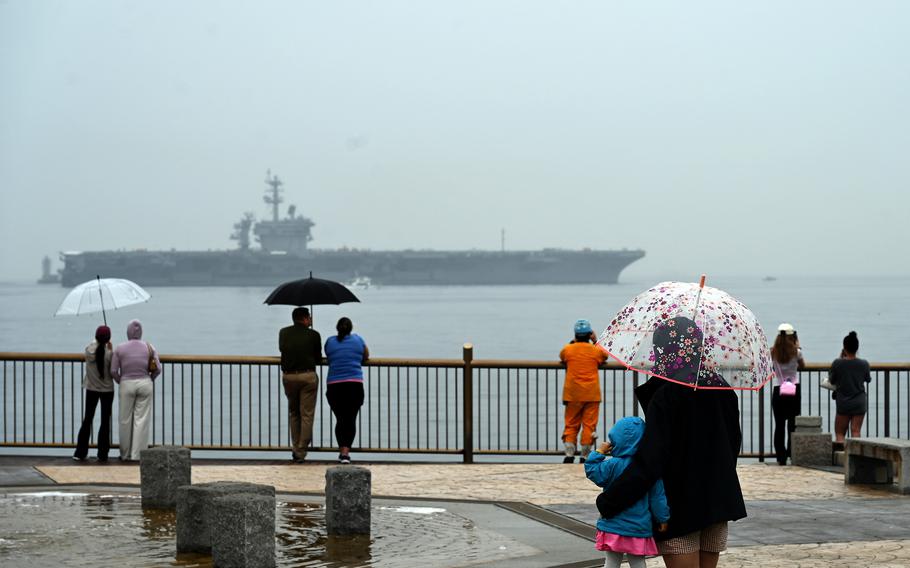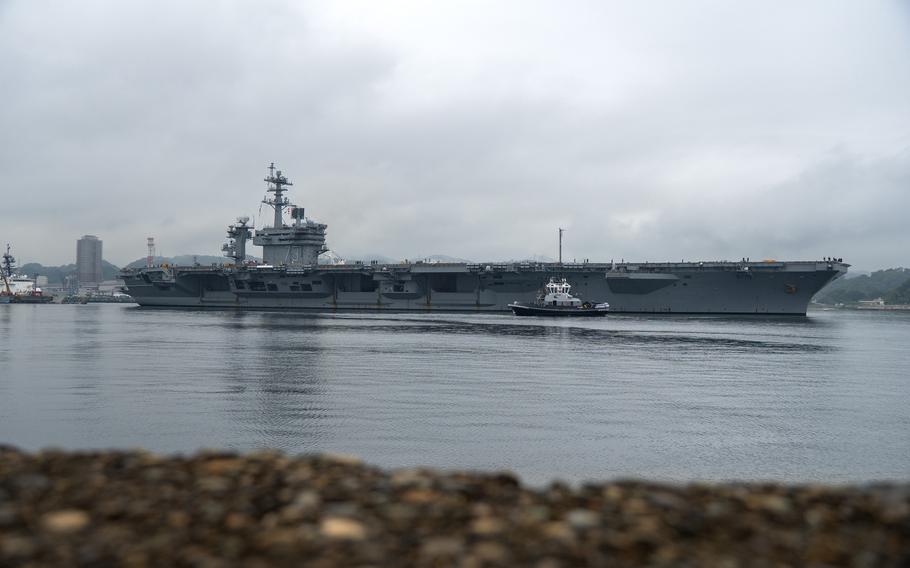USS George Washington’s quiet departure coincides with Chinese naval activity in Pacific | Stars and Stripes

The aircraft carrier USS George Washington departs Yokosuka Naval Base, Japan, June 10, 2025. (Akifumi Ishikawa/Stars and Stripes)
YOKOSUKA NAVAL BASE, Japan — A steady drizzle accompanied the USS George Washington on Tuesday as the aircraft carrier steamed out of Tokyo Bay and began its first patrol since returning to Japan last year.
The vessel departed just before noon to little fanfare, except for about two dozen people who gathered near the carrier’s pier and the shoreline to wave goodbye to their loved ones.
Hannah Corona, wife of catapult officer Lt. John Corona, said it was important to be there, despite the rain, to let the crew know their families support them.
“I feel a lot of pride,” she told Stars and Stripes near the pier. “But it’s also hard to watch them go.”

Friends and family of USS George Washington sailors watch as the aircraft carrier departs Yokosuka Naval Base, Japan, June 10, 2025. (Alex Wilson/Stars and Stripes)
This marks the George Washington’s first deployment since it returned to Yokosuka on Nov. 22, aside from a brief period for sea trials between May 25 and June 4. Carrier Air Wing 5, which will accompany the ship during its deployment, completed carrier-landing practice on Iwo Jima on May 31.
A spokesperson for the U.S. 7th Fleet did not immediately respond to phone and email requests for comment Tuesday afternoon.

A U.S. Navy tugboat escorts the USS George Washington away from Yokosuka Naval Base, Japan, June 10, 2025. (Akifumi Ishikawa/Stars and Stripes)
The George Washington was previously based at Yokosuka from 2008 to 2015 before returning to the United States for midlife nuclear refueling and maintenance. Its sister ship, the USS Ronald Reagan, assumed duties in the region until returning to the U.S. for its own maintenance in May 2024.
During the Ronald Reagan’s tenure, annual patrols typically lasted about six months, beginning in summer. Carriers usually deploy as part of a strike group, which includes guided-missile cruisers and destroyers.
The George Washington’s departure coincides with increased Chinese naval activity in the region.
On Saturday, the Chinese aircraft carrier Liaoning and three other warships entered Japan’s easternmost exclusive economic zone, roughly 185 miles southwest of Minamitorishima, according to a Sunday news release from Japan’s Joint Staff.
Also on Saturday, five additional Chinese warships, including the aircraft carrier Shandong, were spotted about 340 miles southeast of Miyako Island in Okinawa prefecture, the Joint Staff reported Monday.
Japan’s Ministry of Defense said it was the first time both the Liaoning and Shandong – China’s only active carriers – have been seen operating simultaneously in the Pacific, Japanese broadcaster NHK reported Tuesday.
The activity is believed to be part of China’s efforts to expand its blue-water naval capabilities, a Joint Staff spokesperson told Stars and Stripes by phone Monday on condition of anonymity, a common practice in Japan for some government officials.
Was this article displayed correctly? Not happy with what you see?
If you often open multiple tabs and struggle to keep track of them, Tabs Reminder is the solution you need. Tabs Reminder lets you set reminders for tabs so you can close them and get notified about them later. Never lose track of important tabs again with Tabs Reminder!
Try our Chrome extension today!
Share this article with your
friends and colleagues.
Earn points from views and
referrals who sign up.
Learn more
Save articles to reading lists
and access them on any device